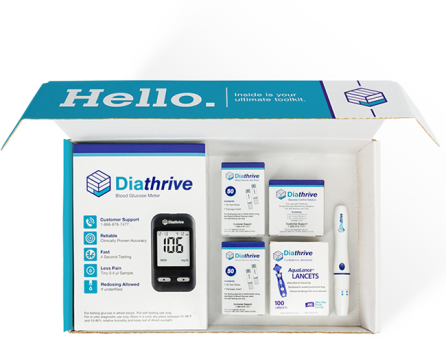
Got diabetes? Got something else, too? You're not alone. Ginger Vieira lives with 3 chronic conditions. Here are her important tips on how to manage multiple chronic illnesses.
When it rains, it pours. And on another note: when you have one auto-immune disease, it’s quite common to have another. In my case, I count three: type 1 diabetes (dx age 13), celiac disease (dx age 14), and fibromyalgia (dx age 28).
A brief explanation of each of these conditions and what they demand:
-
Type 1 diabetes: Well, you probably know all about this one! My immune system attacks and destroys the beta-cells produced by the pancreas that produce insulin. Without insulin, well, we die. Which means I spend every hour of every day trying to adjust and compensate with manual injections of insulin. It’s a never-ending battle to stay “in-range” as all of my fellow T1Ds know all too well.
-
Celiac disease: Also defined by my immune system refusing to cooperate. When gluten (the protein found on wheat, barley, rye, and some other grains) is present in my body, my immune system attacks and damages the lining of my small intestines. Long-term, this can lead to a variety of side-effects. For me, it simply means avoiding gluten. One good thing about celiac disease is that it inevitably encourages you to eat far less processed food since most of the traditional processed cakes, cookies and junk contain gluten. (It’s also VERY common in people with type 1 diabetes!)
-
Fibromyalgia: This one, last but not least, threw a real wrench in my life. Defined by inexplicable pain throughout many parts of your body and bouts of extreme fatigue, I have spent the last 5 years studying my symptoms, my triggers, and my limits. Severe pain and muscle spasms throughout many parts of my body initially left me unable to open my front door, hold my newborn, or even turn my head more than a few degrees. Today, I’m happy to report that I’ve increased my body’s tolerance for exercise from nearly 0 back to some fun, cardio and strength-training...always being mindful of those still very firm limits!
When that second diagnosis comes along, there can be a moment (or many moments) of, “Ugh, again? Why does my body hate me?”
And each diagnosis comes with its own variety of limitations, daily self-care tasks, fears, medications, frequent obstacles, and frustrations.
But there are three critical ingredients in the recipe for thriving with either one chronic illness or several chronic illnesses:
Let go of your self-pity.
Self-pity starts and ends with “why me?” But it doesn’t offer solutions. It doesn’t offer motivation. It doesn’t overcome obstacles. It doesn’t help you live a full life. And it definitely doesn’t help you take care of yourself.
At a certain point, you have to step back and realize that every human being on the planet faces significant challenges in their life, and your chronic illnesses are one of the challenges you will face in your life.
I could’ve spent years feeling sorry for myself that I can’t exercise the way I used to because of my fibromyalgia OR I could start figuring out how to be the most active I can be -- which was a process that took years. And I’m so grateful for the progress I’ve made during those years and the amount I can enjoy exercising today! Self-pity would’ve gotten in the way of this.
When you find yourself wallowing in self-pity, take a minute to remember that there are children with leukemia, people without a warm place to sleep, babies born with debilitating diseases, children starving across the globe, people living in fear of an abuser they can’t easily escape...the list goes on and on!
You are not the only person on the planet who is suffering. Suffering is part of life. But you have the choice to do something with your life that impacts others in a positive way. Turn your self-pity into compassion for another human being and let it fuel you.
Accept the realities of each diagnosis.
Each diagnosis likely demands different things from you. Some of those demands might overlap and some might directly conflict with each other! Write them down.
Take a good look, like a researcher, at what each disease needs from you in order for you to feel your best. Then, decide what you feel capable and willing to do to work towards feeling your best.
I’m so used to living with diabetes and stabbing my body with syringes that I don’t even think of it as a demand anymore, because I don’t remember the feeling of eating a meal without stabbing myself with a syringe! But my fibromyalgia came later in life.
Before my fibromyalgia diagnosis, for example, I was competing in powerlifting and teaching 7 Ashtanga yoga classes a week. Once the symptoms of my fibro became too intense to ignore, I had to accept that these two very intense activities had no place in my life.
To help the pain throughout my entire body calm down, the only exercise I did for a full year was walking my dogs.
Be willing to study and experiment around each diagnosis.
A year or so after my diagnosis, I began to experiment and study every single physical activity and habit that made my fibromyalgia worse versus what I could do to a certain limit.
For example, I knew lifting weights at a rigorous intensity triggered tremendous exhaustion for days afterwards. But I also figured out that I could do very light weights without consequences, giving me a way to very carefully continue strength-training exercise and eventually, finding that I could gradually increase my tolerance for lifting weights over the course of 5 years by sticking to it, and being patient.
I also learned that drinking even 1 glass of wine more than 2 days in a row leads to a flare-up of exhaustion. That getting regular cardiovascular exercise is critical to preventing fibro-induced insomnia. That eating a mostly real-food diet helps every single one of my diseases.
The list goes on and on. Study, study, study.
Acknowledge how much effort you give to each day to stay well.
I recently heard about an ongoing study in California that will demonstrate how much daily stress people with type 1 diabetes face as a result of living with such a high-maintenance chronic illness. The study aims to change how healthcare professionals (HCPs) perceive patients with a disease like this, helping HCPs bear in mind that these patients have chronic stress when discussing their health.
Daily stress. Chronic stress.
If you live with multiple chronic illnesses, there is no doubt that you face a level of daily stress that some of your “normally healthy” friends and family cannot comprehend.
Whether it’s life-or-death decisions around insulin dosing, anxiety over what happens if you don’t manage one of your diseases perfectly, the costs of managing multiple chronic illnesses, advocating for yourself in order to get the care/medications/supplies that you need in order to thrive, juggling the demands of being a spouse/parent/employee with the demands of your health...this list also goes on and on.
By acknowledging how much daily stress you face each day, you give yourself due credit but also inevitable compassion for lightening your load elsewhere. Which brings me to the next suggestion…
Simplify or minimize daily life where you can.
You can’t control the fact that you have multiple chronic illnesses, but you can control some other aspects of life, like how many volunteer opportunities you sign-up for at your child’s school, joining the board at your neighborhood HOA, saying “I can’t make it” to your friend’s wedding on the other side of the country.
Your multiple chronic illnesses are not an excuse, they are a legitimate explanation for why you need to be thoughtful when it comes to spending your energy.
If you’re a parent, for example, you’ve gotta make sure that you have the energy and attention for those top priority items: your daily self-care and the daily care of your children.
Other likely top priorities include your career, your education, caring for your pets, caring for an elderly parent, and supporting your spouse.
Learning how to say “no” to the non-essential parts of life is a critical part of juggling the demands of multiple chronic illnesses.
Life is too short to spend wondering “why me?” Pick yourself up after each diagnosis and figure out what you can do to make the most of life despite multiple chronic illnesses.





